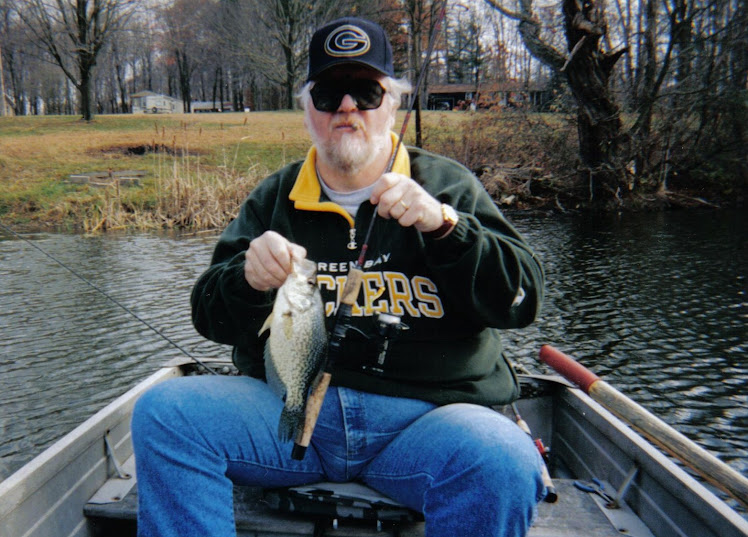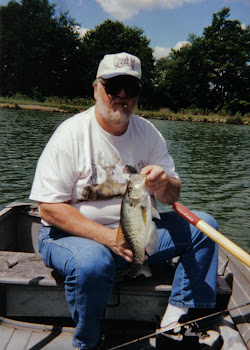This blog will be about some of my fishing adventures while growing up in Ohio. Included will be fishing tips,how to advise,things not to do and in general, just having fun while fishing!
Fall Crappie

Me with a nice Black Crappie and Cigar
Late Summer Crappie

Me with a nice White crappie and Cigar
Monday, December 6, 2010
FISHING THROUGH HARD WATER
The ice is forming on the ponds and lakes! It is the 6th of December, 2010 here in Northeastern Ohio, and by the looks of things, it could be a long and cold winter! This is good news for us ice fishermen! The lake that I fish is a 12 acre pond with the water depth a maximum of 10-12 feet. Once the ice has obtained a thickness of 4"-5" I can be fairly sure it is safe for me to venture out on! As mentioned in my last post, I will cautiously work my way to the areas I want to fish by "TESTING" the ice thickness with a spud bar. The areas I want to fish are the same places we caught fish right before ice up. My auger allows for an 8" diameter hole (Ohio regs call for nothing larger than 12") which has proven to be big enough for the fish I catch! When the hole is opened, I will take my ice jig and lower it to the bottom to get a general depth of the area. I usually start fishing about a foot off the bottom and will shallow up if no bites occur within a few minutes. My choice of bait is generally maggots on the end of a small pin-min type panfish jig. I will load 3-4 maggots then drop the jig through the hole. I use a very small bobber (just large enough to float the jig) and a small split shot about a foot above the jig. On deeper water, a bobber is rarely used and the jigs are allowed to suspend and be vertically worked while watching the line and the "very light" rod tip for signs of a bite. This area of the country offers a couple of larger lakes that hold Walleye but for the most part the fishing is for Bluegill, Crappie and Perch. It always seemed funny that Bluegill are usually a secondary fish when fishing open water but become the primary sought after fish through the ice! Most of the strategy for ice fishing is the same as open water fishing. If you don't find the fish at one spot, move to another or try a different color jig and as mentioned earlier, different water depths! Once the fish are located, they should be in abundance! Other baits that are commonly used are wax worms, minnows and spikes,which are a large maggot. Short rods are made for ice fishing and are adviced due to the fact that they are easier to use because they get you closer to the hole. My rods are no longer that 25"-30" and I have small reels attached with no heavier that 4 pound test mono. The newer flurocarbon line like Berkley's Vantage is great to use! The best advice I can give here is to have really warm boots that are water proof and insulated. There are all kinds of material used now for insulation but to be honest a cheap and effective material is the felt pack liner. For years all I had was a set of felt packs slipped into a pair of old buckle up rubber boots and these worked just fine! You might want to invest in ice spikes or cleats for the bottom of the boots. These really help on a slick ice surface and take it from me, when you slip and fall, hitting that ice is like hitting cement! I carry a plastic 5 gallon bucket that holds all my tackle when I'm moving around and then I use the bucket as a seat and to carry the fish back home! You can spend alot of money on equipment such as a power auger, fancy cold weather gear, sleds to haul your equipment and ice shanties or tents along with heaters and lights, or you can buy or make a good, sharp spud bar, have a decent pair of warm weather coveralls and boots, like I mentioned earlier, buy a cheap ice rod for under $15 and a few panfish jigs plus maggots and be set to go! For the doubters, it will be next to impossible to get them on the ice but for the ones who really enjoy the winter, it's a very interesting way to spent the day and hopefully take home some very good eating!
Subscribe to:
Comments (Atom)